These notes are intended to provide a casual sky watcher or someone already into amateur astronomy living in Eastern Australia with a summary of what is happening in the night sky in November 2012. The finder charts have been produced for an observer based in Brisbane (Queensland, Australia) but will be useful for observers elsewhere in Eastern Australia.
Instructions on how to obtain customised satellite viewing information for your location can be found here. If you find this page of interest, you may wish to follow this website automatically using Twitter and the sites RSS Feed.
Individual sky events (November 2012)
All times listed for the AEST time zone (U.T. plus 10 hours). Add one hour to times listed if your state or territory follows daylight savings time.
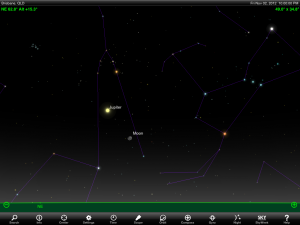
November 1 – 2: Jupiter passes Moon. Look above Eastern horizon after 9.30 pm AEST.
November 2: Moon at apogee 406,050 km 1 am
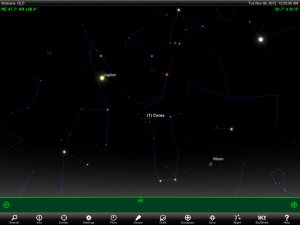
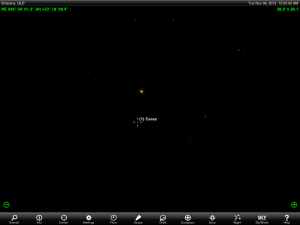
November 5: Minor planet Ceres 0.05 degrees East of Eta Geminorum. Use Eta Geminorum and the finder charts to see your first minor planet or asteroid. Ceres is magnitude +7.9 meaning it is bright enough to see in a pair of binoculars.
November 7: Last Quarter Moon 10.36 am
November 11: Mercury close to Delta Scorpii. Difficult. Look above the South Western horizon in evening twilight.
November 11: Neptune stationary 9 pm
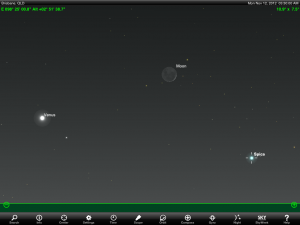
November 12: Venus, slim crescent Moon and the star Spica (the brightest star in the ancient Greek constellation Virgo the Virgin) form a temporary triangle above the Eastern horizon in the dawn sky.
November 13: Saturn 4 degrees North of Moon in morning twilight above Eastern horizon. Very difficult.
November 14: New Moon 8.08 am
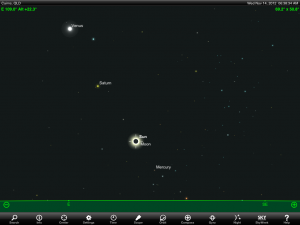
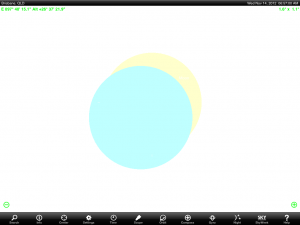
November 14: Solar Eclipse: Partial in Brisbane and total in Cairns. Download a free Solar Eclipse Pinhole Viewer made especially for this eclipse.
November 14: Moon at perigee 357,361 km 8 pm
November 16: Mercury at ascending node
November 16: Crescent Moon located below and to the right of Mars. Look above the Western horizon at the end of evening twilight.
November 18: Mercury in inferior conjunction 2 am
November 21: Mercury at perihelion
November 22: Venus at greatest latitude North
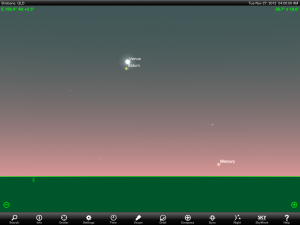
November 27: Venus and Saturn close in the morning sky. If you have a clear horizon, you may be able to spot Mercury very low on the Eastern horizon.
November 29: Full Moon 12.46 am
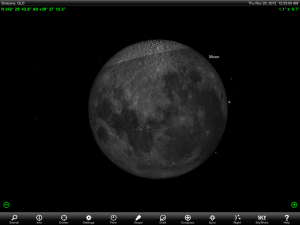
November 29: Penumbral lunar eclipse. Mid-eclipse will be at 12.33am. The eclipse may not be noticeable as the Moon is only passes through the outer and lighter part of the Earth’s shadow
November 29: Moon at apogee 406,362 km 6 am
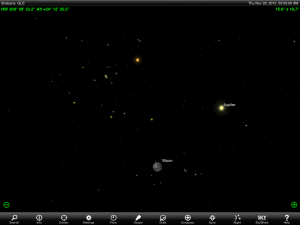
November 29: Jupiter located above and to the right of the Moon in the morning sky
November 2012 Meteor Showers
The Taurid meteor shower is produced by dust from Comet 2P/Encke and it is visible from late evening to early morning. The Taurid South shower has a maximum of 5 meteors per hour under ideal conditions and peaks on 5 November and the Taurid North shower peaks on 11 November with a maximum of 5 meteors per hour.
The Leonid meteor shower peaks on 17 November with an expected maximum of 8 meteors per hour being visible. The radiant (the point at which meteors appear to radiate from) is low on our horizon as seen from the Southern hemisphere reduceing the number of meteors we see.
The alpha-Monocerotids meteor shower is expected to peak on 21 November. The expected peak is five meteors per hour under ideal viewing conditions.
More information about meteor showers can be found on the International Meteor Organisations website at www.imo.net.
For Further Information
Planet and Moon Rise/Set Times
Planet and Moon rise/set times for 2012 can be found here on this website.
Customised Astronomy & Satellite Viewing information
Information on how to obtain customised astronomy & satellite viewing information for your location can be found here on this website.
References
The information in this post has been prepared using the following references.
Occult 4 astronomy software by David Herald, http://www.lunar-occultations.
Astronomy 2012, Quasar Publishing http://www.quasarastronomy.
Sky Safari Pro Ipad app, http://www.southernstars.com/
Stellarium astronomy software http://www.stellarium.org/